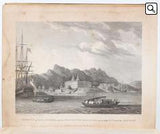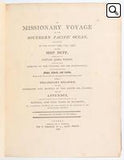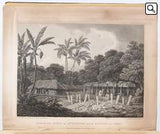A Missionary Voyage to the Southern Pacific Ocean, Performed in the Years 1796, 1797, 1798 in the Ship Duff, Commanded by Captain James Wilson. Compiled from Journals of the Officers and the Missionaries, and Illustrated with Maps. Charts and Views. With
Author: Wilson, James (1760 - 1814)
Year: 1799
Publisher: S Gosnell for T Chapman
Place: London
Description:
a1-4+[2 binders direction]+[8 subscribers]+[4]+c-420+[4 additional subscribers] pages with 7 maps (5 folding) and 6 plates. Quarto (11 3/4" x 9 1/2") with new spine in six compartment with red label in gilt over original decorative blind stamped calf boards. (Ferguson 329; Sabin 104.633) First edition, first printing.
Captain James Wilson brought the first British missionaries to Tahiti on ship Duff in 1797. Wilson was a deeply religious man. The missionaries he brought were from the London Missionary Society. There were thirty men, six women and three children. Wilson, on the Duff also explored and visited many islands in the Pacific, some of which had never had any recorded visit by a European. Among these the most important are Mangareva in the Gambier Islands and Pukarua in the Tuamotus. Duff Paid a visit as a missionary ship to Tahiti during 1796, as a result, Missionary Society has first been established in Tahiti. Three years after the establishment, the directors of the Society appointed a committee to consider a suitable memorial for presentation to Wilson for his services in helping to establish the first mission in the South Seas.
Wilson fought with the British army during the American War of independence and then served nine years with the East India company. While in India he was captured by Hyder Ali and, after a daring bid for escape, was imprisoned in the black hole of Seringapatam. After his release he continued service as a captain and, despite illness and further dangerous missions, accumulated sufficient resources to retire. throughout it all, Wilson remained fast in his irreligious opinions. While living in England with his niece, however, he was converted to an evangelical faith. he felt called to volunteer for missionary service after reading the Evangelical Magazine. Haweis did not know Wilson before receiving a letter volunteering his services in the Pacific. his skills and newfound devotion seemed perfectly suited to the situation, and Haweis saw him as "God's man." the Duff arrived at Tahiti on march 5, 1797. the settlement at Tahiti of twenty of the missionaries, five of them with wives, and two children gives further examples of the role of the missionary captain. A pattern of intercourse had already been established by other voyagers, according to which the captain of a vessel would take the leading role in meetings. It is therefore not surprising that the focus of the chapter describing the arrival is on meetings between significant island figures and Captain Wilson. For example, Manemane, a "high priest" Frommo'orea. sought Wilson as a tayo, or friend, not Jefferson, the president of the missionaries.
The official account of the first mission appeared in 1799, under the lengthy title A missionary voyage to the southern Pacific Ocean, performed in the years 1796, 1797, 1798 in the ship Duff commanded by Captain James Wilson, compiled from the journals of the officers and the missionaries; and illustrated with maps, charts, and views drawn by Mr William Wilson....it was placed firmly within the tradition of the voyages of discovery by an introduction compiled by Samuel Great heed that described previous European contacts with the islands and appendix "including details never before published of the natural and civil state of Otaheite." the main narrative was taken from Wilson's journal, with additions from his son and a journal kept by the missionaries during the period when the Duff was away from Tahiti at Tonga. Wilson dominated the events recorded in the narrative.
Condition:
Some offset toning from maps, occasional foxing, water mark to upper margin on some leaves, two leaves miss-bound at back, re-backed with contemporary blind stamped calf boards.
Year: 1799
Publisher: S Gosnell for T Chapman
Place: London
Description:
a1-4+[2 binders direction]+[8 subscribers]+[4]+c-420+[4 additional subscribers] pages with 7 maps (5 folding) and 6 plates. Quarto (11 3/4" x 9 1/2") with new spine in six compartment with red label in gilt over original decorative blind stamped calf boards. (Ferguson 329; Sabin 104.633) First edition, first printing.
Captain James Wilson brought the first British missionaries to Tahiti on ship Duff in 1797. Wilson was a deeply religious man. The missionaries he brought were from the London Missionary Society. There were thirty men, six women and three children. Wilson, on the Duff also explored and visited many islands in the Pacific, some of which had never had any recorded visit by a European. Among these the most important are Mangareva in the Gambier Islands and Pukarua in the Tuamotus. Duff Paid a visit as a missionary ship to Tahiti during 1796, as a result, Missionary Society has first been established in Tahiti. Three years after the establishment, the directors of the Society appointed a committee to consider a suitable memorial for presentation to Wilson for his services in helping to establish the first mission in the South Seas.
Wilson fought with the British army during the American War of independence and then served nine years with the East India company. While in India he was captured by Hyder Ali and, after a daring bid for escape, was imprisoned in the black hole of Seringapatam. After his release he continued service as a captain and, despite illness and further dangerous missions, accumulated sufficient resources to retire. throughout it all, Wilson remained fast in his irreligious opinions. While living in England with his niece, however, he was converted to an evangelical faith. he felt called to volunteer for missionary service after reading the Evangelical Magazine. Haweis did not know Wilson before receiving a letter volunteering his services in the Pacific. his skills and newfound devotion seemed perfectly suited to the situation, and Haweis saw him as "God's man." the Duff arrived at Tahiti on march 5, 1797. the settlement at Tahiti of twenty of the missionaries, five of them with wives, and two children gives further examples of the role of the missionary captain. A pattern of intercourse had already been established by other voyagers, according to which the captain of a vessel would take the leading role in meetings. It is therefore not surprising that the focus of the chapter describing the arrival is on meetings between significant island figures and Captain Wilson. For example, Manemane, a "high priest" Frommo'orea. sought Wilson as a tayo, or friend, not Jefferson, the president of the missionaries.
The official account of the first mission appeared in 1799, under the lengthy title A missionary voyage to the southern Pacific Ocean, performed in the years 1796, 1797, 1798 in the ship Duff commanded by Captain James Wilson, compiled from the journals of the officers and the missionaries; and illustrated with maps, charts, and views drawn by Mr William Wilson....it was placed firmly within the tradition of the voyages of discovery by an introduction compiled by Samuel Great heed that described previous European contacts with the islands and appendix "including details never before published of the natural and civil state of Otaheite." the main narrative was taken from Wilson's journal, with additions from his son and a journal kept by the missionaries during the period when the Duff was away from Tahiti at Tonga. Wilson dominated the events recorded in the narrative.
Condition:
Some offset toning from maps, occasional foxing, water mark to upper margin on some leaves, two leaves miss-bound at back, re-backed with contemporary blind stamped calf boards.















